Utah’s Five National Parks Offer Stunning Scenery
Canyons, deserts, rivers and hoodoos: Utah’s five national parks offer unparalleled scenery
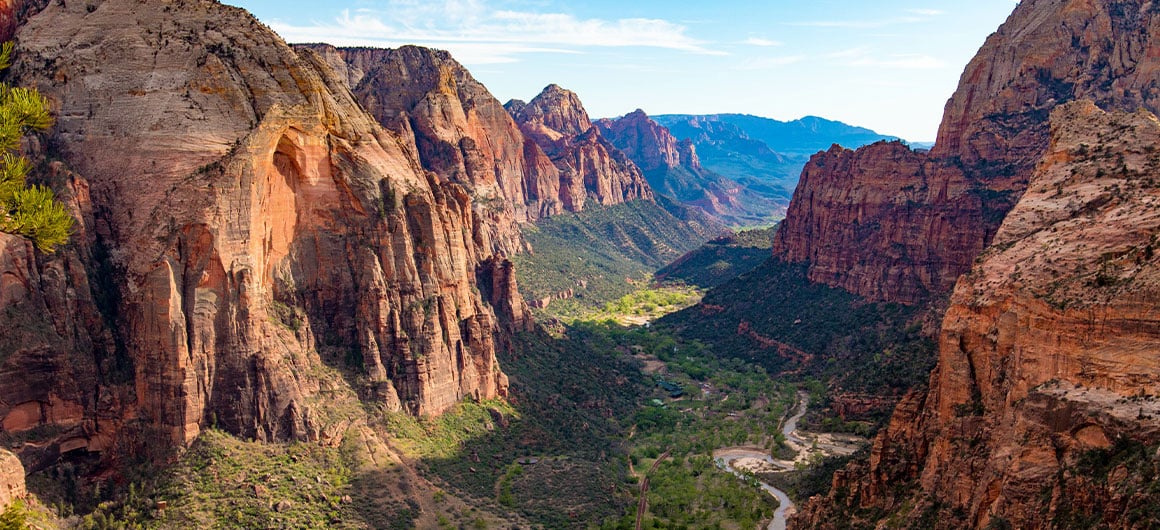
Nowhere else in America packs in national parks like Utah. Mother Nature has worked her magic in the Beehive State, sculpting iconic red-rock arches that frame distant snow-capped mountains, carving canyons into thousands of vertical feet of sandstone and punctuating high-altitude desert slopes with exclamation-point-shaped rock spires called hoodoos.
Collectively nicknamed the “Mighty Five,” each of Utah’s national parks has a distinct personality and landscape, so if you’ve seen one, you certainly haven’t seen them all. Whether you’re in the mood for scenic driving through desert wonderlands or epic hikes in otherworldly landscapes, Utah’s national parks deliver.
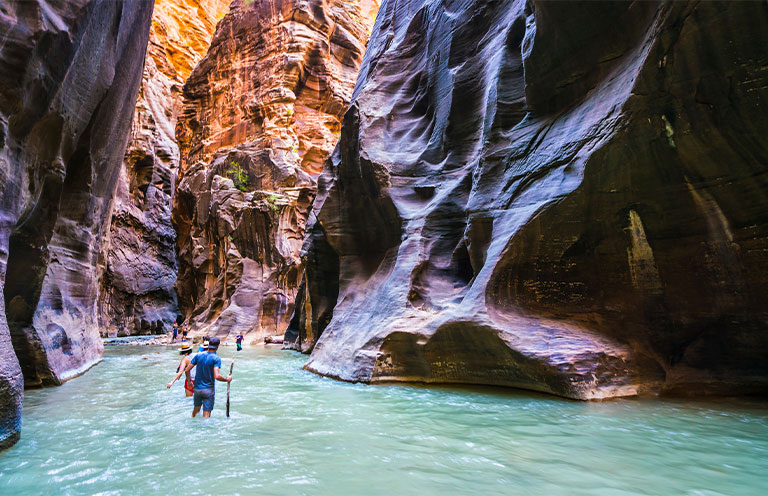
Zion National Park
In the southwestern corner of the state, Zion National Park is Utah’s crown jewel. For thousands of years, the fast-flowing waters of the Virgin River have cut a crevice some 2,000 feet into the rock, creating the soaring red and white sandstone cliffs at the heart of the park.
Angels Landing, one of the most famous hikes in the country, sets off from the base of Zion Canyon, climbing a series of steep switchbacks before traversing the hike’s namesake narrow ridge where hikers pull themselves up by chains before celebrating their vertigo-defying achievement at the hike’s conclusion 5,790 feet in the heavens. The National Park Service introduced mandatory permits in 2022 to manage the crowds.
For hikers who want to stay closer to Earth, the Narrows is a quintessential Zion experience. The trail for this wild trek is the Virgin River itself, and the hiking gets more strenuous as the water rises, eventually requiring you to wade or swim in the river—unless you choose to turn around, as many do. The canyon walls narrow to just 20 feet in width while towering up to 1,000 feet high.
Zion’s natural beauty is no secret—most years, it’s the third-busiest national park in the country after the Great Smoky Mountains and the Grand Canyon. If you can snag a reservation, Zion Lodge is the only non-camping accommodation option inside the park. Nothing beats waking up to Zion’s peaks on your doorstep, but the gateway town of Springdale has tons of options, too, from hotel chains to personality-filled bed-and-breakfasts.
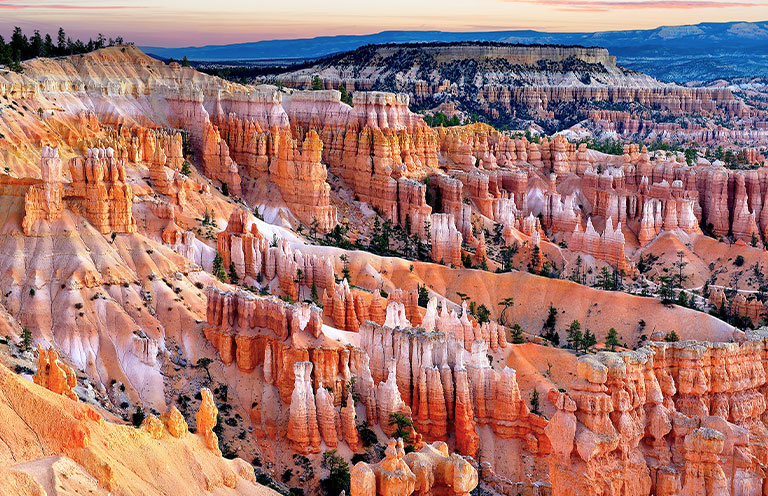
Bryce Canyon National Park
Many travelers visit Bryce Canyon National Park—about a 1.5-hour drive from Zion’s east entrance—as a day trip, but it’s not hard to find reasons to linger. Despite its name, Bryce is not a canyon but the sloping side of a high-elevation plateau, where the curious pastel-colored hoodoos spill into a wide pine-studded natural amphitheater. The 18-mile rim road is a stunning scenic drive, but nothing beats walking among the hoodoos instead of seeing them from on high. Hiking trails wind down from the rim, most popularly at Sunset Point and Sunrise Point, or you can ride through the rocks on horseback with Canyon Trail Rides.
Completed in 1925, the Lodge at Bryce Canyon is now the sole original survivor of the historic hotels built on the “Grand Circle” tour route that took 20th-century visitors around Zion, Bryce and Grand Canyon national parks. Book a room in one of the classic cabins from that era instead of the more recently built motel-style rooms. Another good reason to stay the night is Bryce’s awesome dark-sky programs, which include ranger-led full moon hikes and an annual astronomy festival in June.
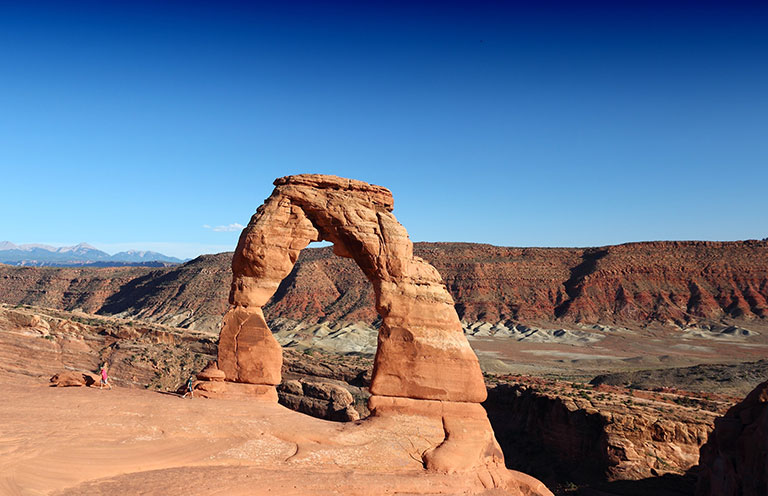
Arches National Park
More than 2,000 natural rock arches bow gracefully before a backdrop of scrub-dotted desert and distant snowy summits at Arches National Park, home to the highest concentration of arches in the world. The formations range from 306-foot-long Landscape Arch, one of the largest in the world, to Delicate Arch, a span that resembles a pair of cowboy chaps.
Most hikes in Arches are on the shorter side and within easy reach of the park’s main scenic drive. Longer and more adventurous trails include the primitive route around Devils Garden and Fiery Furnace, the only trail in the park that requires a permit because it’s so easy to get lost among its labyrinthine rock fins. Rangers lead tours if you’d rather not go it alone.
Arches has seen a huge increase in visitors, leading the National Park Service to require timed entry tickets between 7 a.m. and 4 p.m. from April through October. Moab, the closest town, is rich in accommodation and dining options, but more scenic stays abound along Highway 128, the Upper Colorado River Scenic Byway. Many of the rooms at Red Cliffs Lodge, for example, look out on the mighty river, a view best enjoyed from the hot tub.
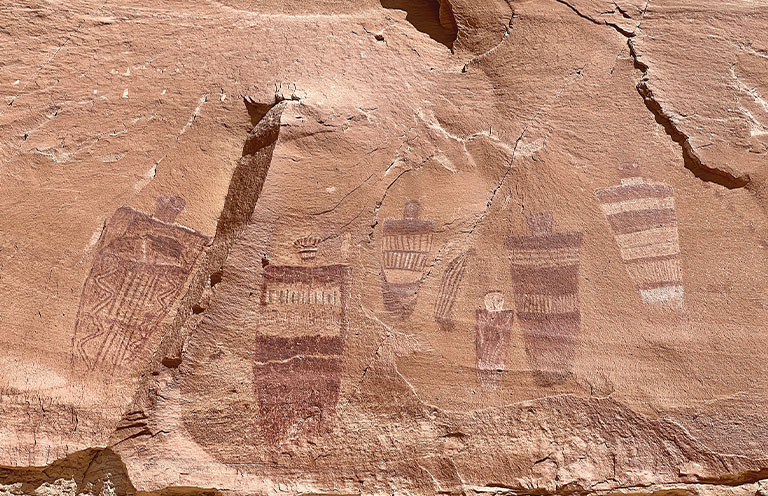
Canyonlands National Park
Utah’s least-visited national park is also its largest, covering 527 square miles. Divided into four disparate districts, Canyonlands is best approached in several trips. It’s impossible not to be wowed by the enchanting vistas stretching hundreds of miles from the high plateaus of Island in the Sky, the most visited of Canyonlands’ districts thanks to its proximity to Moab and Arches National Park. Over millennia, the Colorado and Green rivers have swept away layers of rock, leaving behind the precipitously deep canyons that give this park its name. The rivers themselves are another district, a favorite of whitewater rafters.
Much of the Maze district, west of the two rivers, is a seriously rugged area best left to travelers with deep backcountry knowledge.
South of Moab, Canyonlands’ Needles district tempts hikers and solitude seekers with trails around orange and white sandstone pinnacles as well as traces of the Native people who have called this place home.
The Needles district has a campground, but other lodgings are at least an hour’s drive away. The spacious canvas tents at ULUM Moab, one of Utah’s best places to stay, put a luxe spin on staying in the great outdoors.
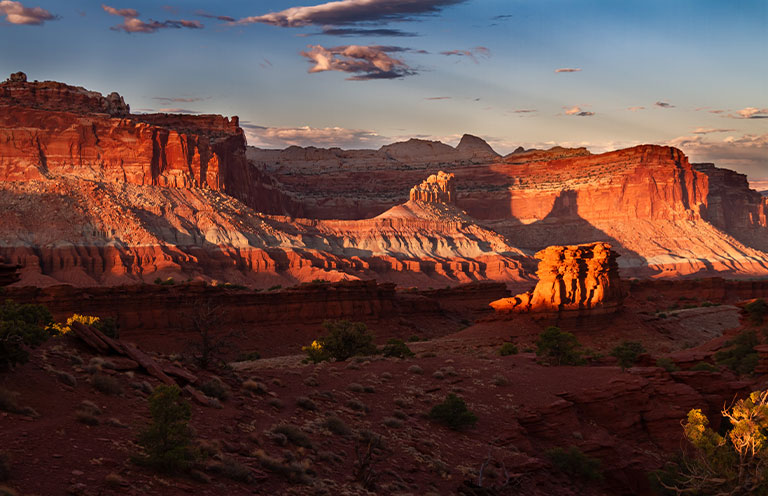
Capitol Reef National Park
Visitors might be puzzled by the name of Capitol Reef National Park, which sits squarely in the central Utah desert far from any major bodies of water. Early white settlers thought the gleaming sandstone domes looked like the Capitol building in Washington, DC, and because overland travel by wagon was made challenging by the Waterpocket Fold, an 87-mile-long wrinkle in the Earth’s crust that’s largely encompassed by the park, they viewed it as a sort of a barrier “reef.” Some Native tribes called the area the Land of the Sleeping Rainbow in reference to the beautifully colored rocks.
A hike along the Capitol Gorge Trail takes you past petroglyphs carved by the Fremont people and a more recent set of carvings called the Pioneer Register, where 19th-century gold prospectors and Mormon settlers etched their names.
The gateway to Capitol Reef is Torrey, which has surprisingly delightful places to stay for a town with a population of just 262. At one such offering, Skyview Hotel, you reach some guest rooms by walking through a “slot canyon” art installation, or you can spend the night stargazing from bed in a geodesic dome.
. . . . .
No matter how—or how many of them—you choose to tackle, Utah’s Mighty Five show off some of the best natural wonders in the entire country and cast a captivating spell that’s sure to lure you back.
